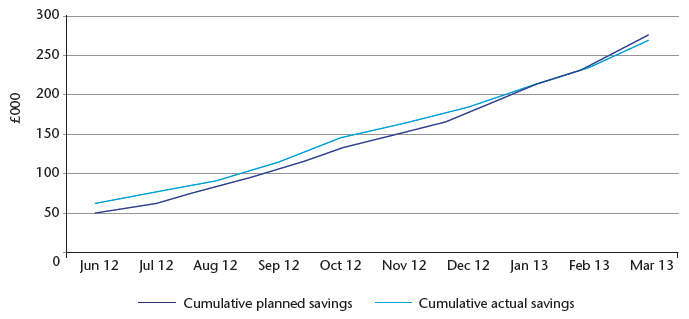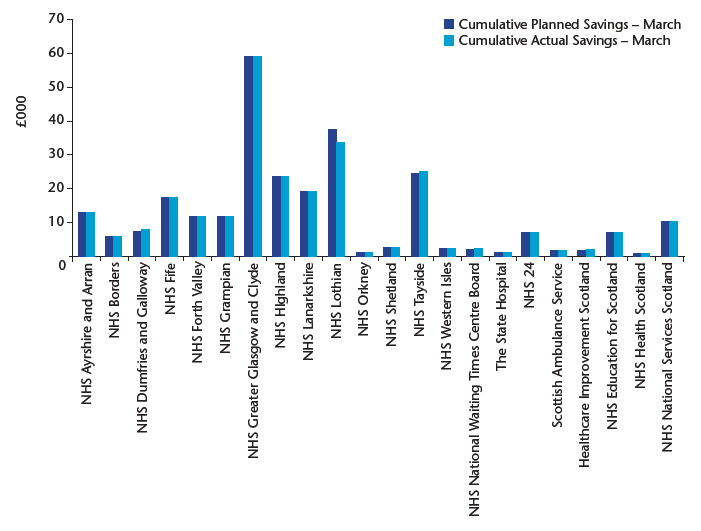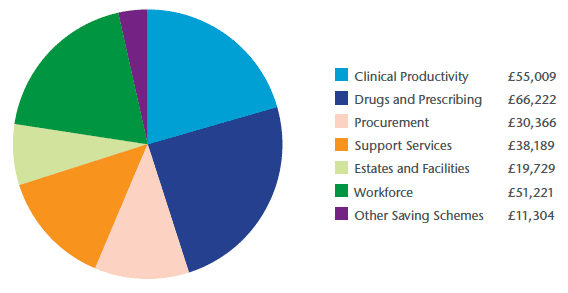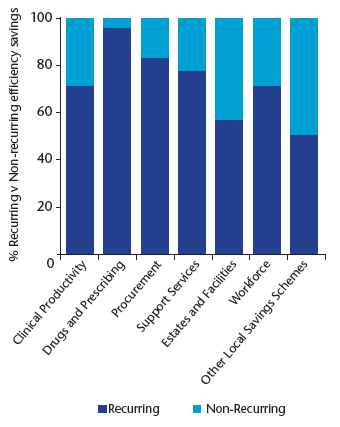Healthcare quality and efficiency support team: annual report 2013
Annual report in relation to improving the quality and efficiency of healthcare in Scotland.
Appendix 1 Efficiency Savings 2012-13
Planned v Actual Efficiency Savings
NHS Boards are required to identify planned efficiency savings as part of their Local Delivery Plan (LDP). The achievement of these savings is monitored on a monthly basis. Chart A1 illustrates the planned and the reported actual efficiency savings achieved by NHSScotland during 2012-13.
Chart A1: NHSScotland planned v actual efficiency savings

Overall the achievement of actual savings has been slightly ahead of those planned throughout the year. However, by March 2013 actual savings were in line with those planned at £270 million (£264 million target).
In the majority of cases the reported savings were in line with, or greater than, those planned per NHS Boards' LDPs. Chart A2 shows the planned and actual savings per NHS Board.
Savings per Efficiency and Productivity Workstream
The efficiency and productivity workstreams align to the savings categories in NHS Board LDPs and monthly monitoring returns as outlined (table A1).
Chart A2: Planned v actual efficiency savings per NHS Board

Table A1
| Efficiency and Productivity Workstreams |
Categories per LDP |
|---|---|
| Prevention and Early Intervention |
|
| Outpatients, Primary and Community Care |
Clinical Productivity |
| Prescribing |
Drugs and Prescribing |
| Procurement |
Procurement |
| Shared Services |
Support Services |
| Workforce |
Workforce |
Chart A3: Efficiency savings per workstream

Chart A3 details the proportion of reported savings achieved through each of the workstreams.
- A quarter of efficiency savings achieved in 2012-13 relate to prescribing. This is a significant increase in both absolute (2012-13, £66 million; 2011-12, £33 million) and proportionate terms (2012‐13, 25 per cent of total; 2011-12, 10 per cent of total).
- Workstreams associated with clinical productivity delivered 20 per cent of the savings total amounting to £55 million. There is a decrease in the proportion of savings delivered as a result of improvements in clinical productivity (2011-12, 28 per cent of total amounting to £89 million).
- Workforce workstreams delivered 19 per cent of the savings total (2011-12, 17 per cent of total).
- Procurement, Support Services, and Estates and Facilities each delivered between 7 per cent and 14 per of the savings total. This is broadly in line with the previous year.
- A small proportion (3 per cent) of savings was delivered through other local saving schemes.
Recurring v Non-Recurring Savings per Efficiency and Productivity Workstream
Recurring savings are those which once achieved recur year on year from that date (e.g. savings on staff costs as a result of streamlining processes). Non-recurring savings are those which are one-offs (e.g. receipt from the sale of a fixed asset, such as a building). It is important that savings are recurring to ensure sustainability of the financial position and to reduce the risk of non-achievement of savings targets in future years.
Chart A4: Recurring v non-recurring savings per efficiency and productivity workstream

Chart A4 details the proportion of recurring and non-recurring savings achieved through each of the workstreams.
- £211 million (78 per cent) of savings across all workstreams are recurring; this is in line with 79 per cent recurring savings in 2011-12
- 96 per cent of prescribing savings are recurring (2011-12, 99 per cent)
- Estates and facilities have the lowest proportion of recurring savings (57 per cent)
- Where NHS Boards have made savings classified as other local saving schemes almost half of these are non-recurring (49 per cent)
- The remaining workstreams have achieved recurring savings of between 72 per cent and 83 per cent
Contact
Email: Dayna Askew
There is a problem
Thanks for your feedback